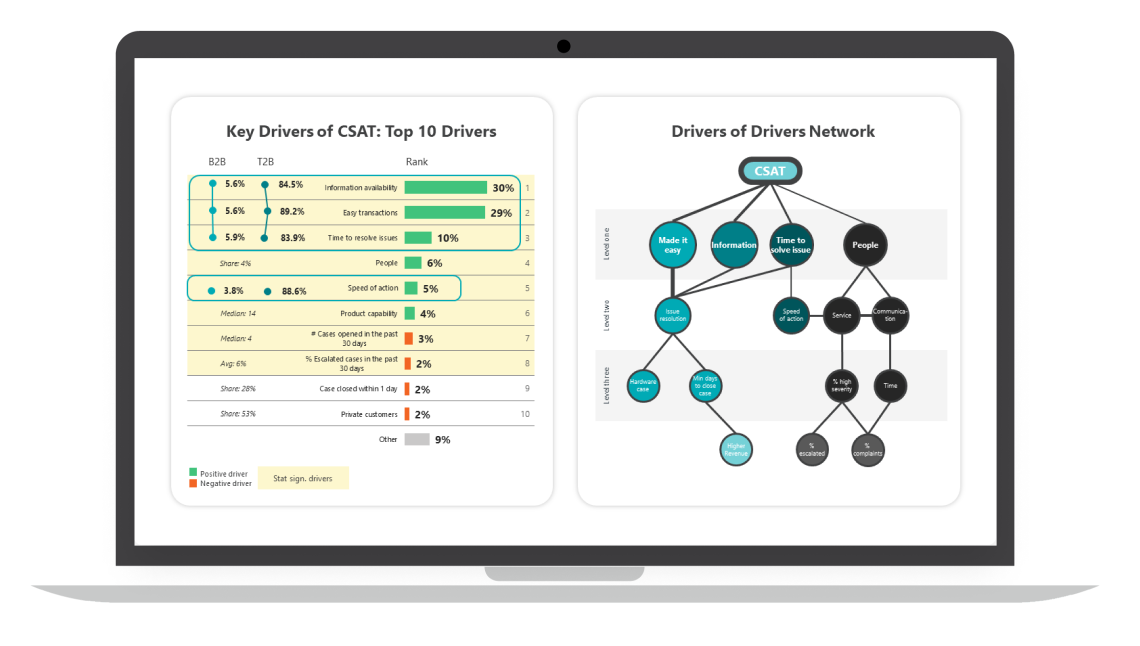
Surveys alone are not enough for 4 out of 5 CX leaders* to identify the root causes of customer satisfaction and prioritise improvements with the highest impact on customer experience. Root Cause Analysis studies the cause-and-effect relationships between key drivers and customer experience and demonstrates how drivers influence each other. It is a powerful prioritization tool when it’s complicated to decide where to focus improvement efforts.
Go deeper than standard key driver analysis by investigating the cause-and-effect relationships and how drivers influence each other.
Understand what drivers have the highest impact on customer experience and focus your resources where it matters.
Identify the most significant drivers for different journeys, segments or products and enable targeted actions across the organization.
Prove the need to invest in improvements for hygienic or must-have drivers once and for all.
Includes important themes that occur less frequently but have huge impact once they happen.
Looks at the causal relationship between themes and CX metrics.
Illustrates how drivers influence each other in a real environment.
Differentiation of drivers as must-have, nice-have or hygienic.
Key Driver Analysis (KDA) and Root Cause Analysis (RCA) both identify factors impacting customer experience or satisfaction, but they differ in purpose and approach. KDA pinpoints influential factors affecting satisfaction using statistical techniques, guiding businesses in prioritizing resources for maximum impact on customer experience.
Conversely, RCA systematically uncovers underlying causes of customer experience issues, moving beyond symptoms to find fundamental reasons. This process includes data collection, cause-and-effect analysis, and solution identification, aiming to prevent recurrence and improve customer experience by addressing root causes and implementing corrective actions.
Many companies we work for find the KDA doesn't give them enough details regarding actions they need to do to improve customer experience hence they look into the more detailed Root Cause Analysis models.
The model for Root Cause Analysis in customer experience and satisfaction relies on a combination of survey data and, optionally, internal data to provide a comprehensive understanding of the factors affecting satisfaction levels.
Minimum requirements:
Optional items for a more comprehensive model:
By incorporating these data sources, the Root Cause Analysis model can effectively identify underlying causes of customer experience issues and guide the implementation of targeted solutions for improving satisfaction.
Root Cause Analysis (RCA) is a versatile method that can be effectively applied across various industries and business models to improve customer experience and satisfaction. It is particularly beneficial for industries where customer feedback plays a crucial role in driving business success. If you have any type of customer feedback program, customer experience program or other type of program that includes customers giving you a score, Root Cause Analysis will be beneficial to you.
Both depend on the amount of data, markets, business units, products or other details you want to delve in. A standard delivery timeframe would be between 6 and 8 weeks. As to pricing, we offer a flexible model with one-time set up fees and quarterly subscription for updates afterwards.
Join our newsletter
By subscribing you agree with our Privacy Policy
Privacy Policy
Terms of Service
Cookies Settings
Copyright NPS® is a registered trademark, and Net Promoter Score℠ and Net Promoter System℠ are service marks, of Bain & Company, Inc., Satmetrix Systems, Inc. and Fred Reichheld.
Web development by MySuper.Site